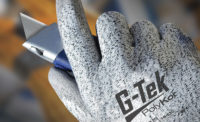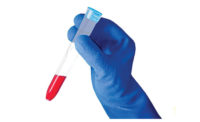Since the early 1900s, when the first safety eyewear was developed and used, clear has been the most popular safety lens color. For decades, clear lens options have been useful and reliable. They provide general protection and help workers avoid eye injuries by giving them protection from dust, debris and impact, encountered on many job sites. But in most cases, they do not offer a solution to address one of the most serious issues affecting workers today: reflected light. Reflected light is found in most workplaces including laboratories, factories, warehouses and construction sites.
With standard safety glasses, light scatters or reflects off of a lens at many angles. This causes annoying glare and results in an inability to clearly see objects directly in front of you. These reflections cause the eye to work harder in order to focus clearly. The brighter the light, the more profound this issue can be. As the day goes on, the eye will strain to focus, resulting in eye fatigue. Eye strain and eye fatigue are among the key factors that can reduce worker efficiency and productivity. Multiple light sources and high intensity lighting increase eye strain and fatigue, affecting the worker’s ability to focus on their task. As visual acuity is reduced, eye strain is increased and costly mistakes or injuries can occur.
These issues have been continuously analyzed, resulting in the development of new lens technologies that provide the enhanced performance needed to better protect workers’ eyes.
Advanced solution for indoor environments
Anti-reflective lenses reduce reflections and glare that would otherwise impact the worker’s vision. Additionally, they allow 96 percent of available visible light to pass through the lens and enter the eye as compared to 88-92 percent with standard clear lenses. The result: better visual acuity while helping reduce eye strain and eye fatigue. The clarity they provide also helps increase comfort, performance and productivity. This allows for comprehensive protection from a variety of potentially damaging light sources.
When you consider how many indoor work environments are exposed to multiple light sources, it’s easy to see where anti-reflective lens technologies can provide some of the greatest benefits:
• In the pharmaceutical industry, high-tech manufacturing, quality control processes and inspection applications, bright lighting is often prevalent, in order to increase visibility. This lighting is also positioned at multiple angles to reduce shadows and allow for optimal viewing. But those same light sources can increase lens glare and reflections.
• Manufacturing plants and warehousing operations also encounter their own issues with glare and reflections from multiple light sources. Sunlight coming through windows and bright overhead lighting increase the potential for glare and annoying reflections.
A new advanced option for outdoor environments
As bright as certain indoor lighting environments can be, nothing can compete with the sun’s intensity, especially on a clear day. Standard tinted and mirror lenses help deflect the sun’s light and brightness though glare and reflections can continue to be an issue. This kind of environment is perfect for polarized lens eyewear.
Polarized lenses have long been an enhanced solution. By controlling the angle at which light enters the lens, polarized lenses do a tremendous job of reducing glare so workers can have a clearer view of their work and their environment. The most profound effects occur in environments where sunlight is reflecting off of relatively flat surfaces, such as water, snow or road surfaces.
In the event polarized lenses are not the ideal choice, anti-reflective lens technology, combined with a mirror lens coating offers an alternative solution. The darker shade provided by the mirror coating will help deflect the sun’s glare, enabling the eyes to better adjust to the environment.
Evaluating performance
Almost every work environment can contribute to persistent eye strain, which can lead to eye fatigue over time. Utilizing anti-reflective lens technology can make a huge difference in alleviating it altogether.
Any potential solution should be tested and evaluated before it is implemented. With anti-reflective lens technologies, it is strongly encouraged so that the worker can truly experience the difference between lenses with and without this enhanced feature. The difference between anti-reflective lens technology and ordinary lenses can be observed in as little as three days. After wearing safety glasses with anti-reflective lenses for three days, ask workers to switch back to the standard lens they previously used – clear, gray tint, or mirror tint. The difference will be perfectly clear.


